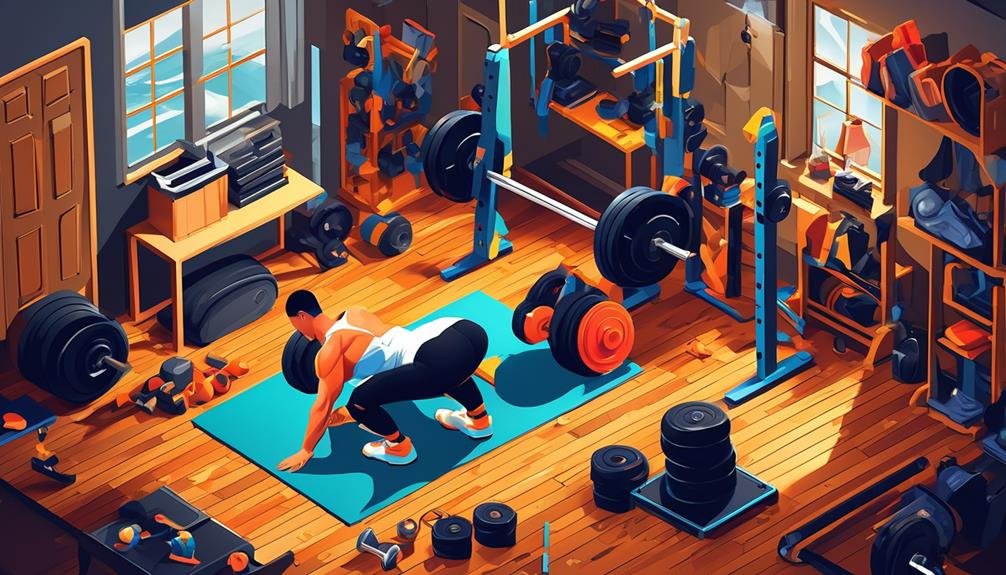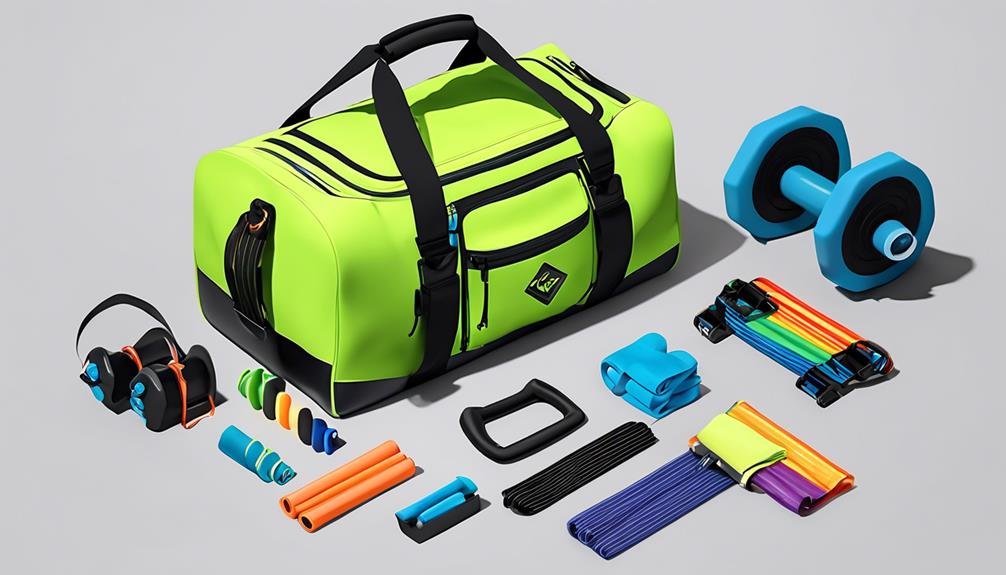They say 'prevention is better than cure,' and when it comes to exercising in your home gym, this adage holds true. While working out in the comfort of your own space can be convenient, it's crucial to be aware of the exercises that pose a higher risk of injury.
From bicycle crunches to behind the head lat pull-downs, there are certain movements that should be approached with caution. But fear not! In this discussion, we will explore the exercises you should avoid and why, ensuring your safety remains a top priority.
So, let's dive in and uncover how you can get the most out of your home workouts while minimizing the risk of injury.
Key Takeaways
- Twisting too quickly during bicycle crunches can strain muscles and cause spasms, so it's important to maintain a slow and controlled pace.
- Pulling the bar behind the head during lat pull-downs can stress the shoulder joint and increase the risk of impingement or rotator cuff tears, so it's advisable to switch to alternative exercises if shoulder discomfort occurs.
- Improper technique during kettlebell swings can result in rotator cuff injury or inflammation, so it's essential to generate power from the glutes and hamstrings and control the speed and force of the swing.
- Poor posture during bent over rows increases the risk of lower back strain and lumbar disc displacement, so it's recommended to start with a comfortable weight, engage core muscles, and consider alternative variations for better support.
Bicycle Crunches
Bicycle crunches can pose a risk of injury if performed incorrectly or with poor form. It's important to understand the potential risks associated with this exercise to prevent any harm. When doing bicycle crunches, be cautious of twisting too quickly, as it can strain your muscles and lead to spasms. In addition, losing midsection tension during the exercise can strain your low back and potentially cause injury. Another common mistake is clutching the back of your head and craning your neck, which can injure your cervical spine.
To perform bicycle crunches safely, always maintain a slow and controlled pace. Beginners should consider alternative core exercises until they've built up enough strength and stability. It's also advisable to seek guidance from a personal trainer to ensure proper form and technique. Incorporating a full range of motion and avoiding excessive strain can significantly reduce the risk of back injury.
If you experience any pain or discomfort during bicycle crunches, it's important to seek medical advice to address any potential muscle imbalances or underlying issues. Remember, exercising safely is essential for a successful strength training routine.
Lat Pull-Downs (Behind the Head)
To minimize the risk of injury, it's important to be cautious when performing lat pull-downs behind the head. This exercise primarily targets the back muscles, specifically the latissimus dorsi, which is one of the major muscle groups in the upper back. However, performing lat pull-downs behind the head can increase the risk of back injury if not done correctly.
When you pull the bar behind your head, it places stress on the anterior joint capsule of the shoulder, which can lead to impingement or even rotator cuff tears. It's essential to be aware of vulnerable positions and listen to your body. If something feels wrong in your shoulder while performing this exercise, it's advisable to switch to a different exercise that targets the same muscle group.
To prevent injury, it's crucial to consult a therapist or trainer who can guide you on the proper technique for lat pull-downs. They can help you find alternative exercises that involve the same muscle groups without the risk of incorrect form or increased injury.
Kettlebell Swing

Using proper technique and caution is crucial when performing the Kettlebell Swing to minimize the risk of shoulder injury. The swinging motion of the kettlebell puts the shoulder at risk, especially when the exercise is done improperly. Improper technique can result in rotator cuff injury or inflammation.
To prevent injuries, it's important to generate power from the glutes and hamstrings, rather than relying on the shoulder muscles alone. Before starting the swing, it's essential to learn the correct way to move the weight. This involves understanding how to properly hinge at the hips and engage the core.
Additionally, it's important to ensure that the speed and force of the swing are controlled. Sudden jerky movements can increase the risk of injury, particularly to the lower back.
Bent Over Rows
Performing Bent Over Rows with poor posture can increase the risk of lumbar disc displacement and nerve compression, leading to potential injury. When you hinge from the waist during bent over rows, it contributes to poor posture and shoulder rolling, which increases the risk of back injury.
This exercise places a lot of stress on your back, especially the lumbar spine, so it's crucial to maintain proper form. One common mistake is using too much weight, which can compromise your form and increase the risk of injury. It's important to start with a weight you can handle comfortably and gradually increase it as you build strength.
Another mistake is neglecting to engage your core muscles, which can lead to excessive strain on your lower back. To reduce injury risk, consider alternatives such as performing rows lying face down on a Swiss ball or bench. These variations provide support for your back and help maintain proper posture.
Remember to seek guidance from a trainer if needed to ensure correct technique and form for bent over rows.
Romanian Deadlift

Maintain proper form and posture to reduce the risk of back injury when performing the Romanian Deadlift. This exercise can be highly beneficial for strengthening your lower body, but it's essential to execute it correctly to avoid potential harm. Before attempting the Romanian Deadlift, make sure you have a good understanding of the proper technique and seek guidance from a qualified fitness instructor if needed.
One crucial aspect of this exercise is keeping your back straight and avoiding rounding it when lifting or lowering the weight. By focusing on maintaining proper form and posture throughout the exercise, you can minimize the risk of injury. Improper execution may lead to hyperextension through the low back, which can be detrimental to your health.
To perform the Romanian Deadlift correctly, start by standing with your feet shoulder-width apart and holding a barbell or dumbbells in front of your thighs. Keep your knees slightly bent and hinge at the hips, pushing your glutes back as you lower the weight towards the ground. Make sure to engage your core, and avoid excessive low back arching.
Frequently Asked Questions
What Exercise Is Most Prone to Injury?
The exercise most prone to injury is the one that involves twisting at high speeds, such as bicycle crunches. These can lead to herniated discs and muscle spasms.
What Exercise Would Have a Lower Risk for Injury?
To lower your risk of injury, focus on exercises that prioritize proper form, full range of motion, and gradual intensity increase. Incorporate rest, recovery, and cross-training, listen to your body, and adjust exercises as needed.
What Are the Unsafe Exercise Techniques?
Avoid high-speed bicycle crunches, lat pull-downs behind the head, improper kettlebell swings, bent over rows with bad form, and incorrectly performed Romanian deadlifts. These exercises can lead to herniated discs, shoulder impingement, shoulder injury, lumbar disc displacement, and low back hyperextension.
What Are Two Risky Exercises and Why They Are Risky?
Avoid bicycle crunches, as they can cause herniated discs and muscle spasms from twisting. Also, steer clear of lat pull-downs behind the head, which may lead to shoulder impingement or rotator cuff tears.
Conclusion
In conclusion, when setting up a home gym, it's important to be aware of exercises that should be avoided due to the risk of injury. These include:
- Bicycle crunches
- Behind the head lat pull-downs
- Kettlebell swings
- Bent over rows
- Romanian deadlifts
- Overhead squats
- Backward medicine ball rotation tosses
- Seated leg extensions
- Pull-ups
- Preacher curls
Prioritizing safety and seeking professional guidance for proper technique and modifications can help prevent injuries and ensure a safe workout environment.





